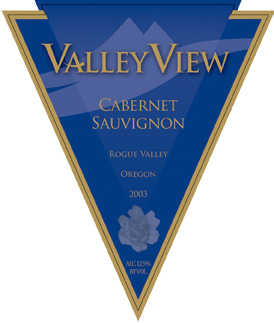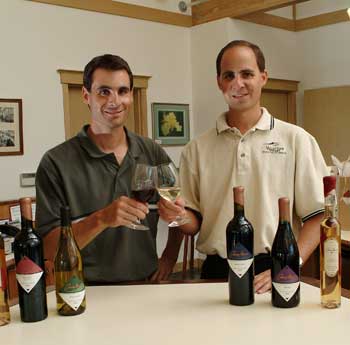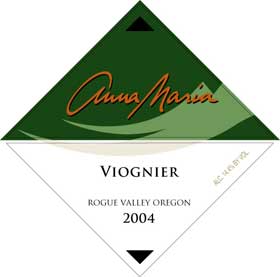

Valley View Winery sources the fruit for its wine from the nearby Rogue (River) Valley and from its vineyards in the Applegate Valley sub-AVA of Southern Oregon.
One of the Oldest Wineries in the Southern Oregon AVA Has Some New Ideas
Mark and Mike Wisnovsky operate Valley View Winery in the Southern Oregon AVA sub appellation Applegate Valley. While they have been involved in the wine industry there longer than any other current producer, they are always looking to the future.
by
Cole Danehower
April 2, 2007
Mark Wisnovsky (MW): The greatest benefit I see is that it has given our region an identity for the rest of Oregon and the region. This has helped generate media tours, grant money, etc. from the state. It remains to be seen whether “Southern Oregon” as an appellation has benefited the marketing of our wines.
CD: Where does Southern Oregon fit into the landscape of the Oregon wine industry?
MW: That is a tough question! The easy answer is that Southern Oregon wines complement the entire industry but, even after 30 years of winemaking, it still seems like we have two (or even three) separate wine areas/states in Oregon. It certainly appears at times that we market “together” simply because we are located in the same state and have a centralized marketing group.
You cannot overestimate the differences between Northern and Southern Oregon, whether in winemaking or many other areas. Perhaps if opposites attract,

Brothers Mike (left) and Mark Wisnovsky took over the Valley View Winery business from their father and have made it into one of the most popular wineries in the Southern Oregon AVA.
CD: How difficult is it to compete against the fame of the Willamette Valley, the reputation of eastern Washington, and the wine flood of California?
MW: The greatest “competition” we face from the Willamette Valley is from Portland area restaurants and wine shops who are simply not that familiar with Southern Oregon and believe that carrying 10 Oregon Pinot Noirs and Pinot Gris by the glass constitutes “an Oregon wine list.” We have a long way to go to get our own state’s accounts to look at Southern Oregon’s myriad of varietals for consideration.
In many regards, we face greater competition from Eastern Washington because of the similar varietals. Most of the wine lists mentioned above will get the majority of their Chardonnay, Cabernet Sauvignon and Merlot from Washington, when they should be considering Southern Oregon wines as well. It seems that we face more competition from California wines locally in Southern Oregon because of our proximity to the state and the number of people visiting from California. Consequently, California wine sales in Southern Oregon are naturally strong.
CD: Does Southern Oregon have a signature style, varietals, terroir or character? Are any of these important to the future of the region?
MW: If there is a signature style, I believe it would be a more focused purity of fruit. Traditionally, there is not a great amount of oak flavoring and a bit more earthy flavors in Southern Oregon wines. Although acidity levels are usually relatively low, I have always found that the wines are well balanced with good longevity.
 I don’t think that some type of “signature style” is that important if we are generally focusing on regional sales. Perhaps if we begin to focus on a few “newer” varietals like Tempranillo and Viognier, then a “style” will eventually develop.
I don’t think that some type of “signature style” is that important if we are generally focusing on regional sales. Perhaps if we begin to focus on a few “newer” varietals like Tempranillo and Viognier, then a “style” will eventually develop.
Mike Wisnovsky: It would be easier to market our wines if we had only produced a handful of varieties and every winery produced the same style of wines, however that is not what our climate gives us. Southern Oregon has a tremendous climate variation within the appellations, which allows us to ripen many different varieties as well as vastly different flavors within the same variety. This is our greatest advantage but it is also our greatest marketing obstacle.
CD: So are there other big risks facing Southern Oregon today?
MW: The greatest risk for any wine region is poor quality wines. Every winery benefits (or suffers) with every other winery’s wine quality. As Southern Oregon’s wineries and vineyards mature, we are seeing much more consistent quality throughout.
I suppose that, since we are positioning ourselves to rely ever more on retail sales, there could be a risk there as well but I have to believe that you are more likely to lose loyalty among customers 1000 miles away than those right next door.
CD: What is the greatest opportunity that Southern Oregon faces today?
MW: Southern Oregon wines are in an exciting phase today when it comes to discovering the best wine grape varietals that can be produced in the various diverse microclimates. This naturally lends itself to a wine region that is primarily dependant on retail and regional sales since the possibly large number of varietals and blends require a more “hands-on” marketing approach.
Potentially, this has great benefit as educated wine consumers can experience a vast array of quality wines in a relatively short trip.
CD: Your brand is among the most venerable in Southern Oregon — from your experience, how has the region changed in the last five years, from a winegrowing perspective, from a winemaking perspective, and from a market perspective?
MW: Unlike in the past, the growing awareness and sales of Southern Oregon wine positively affects all these questions. Increased market acceptance influences everything we do, from what varieties we grow to the style of wine that we produce.
In essence, our job has become to ensure that we grow the right grapes that fit our various microclimates and then produce the best wine that we can from those varieties. That is, we don’t try to force a popular variety into an area that may not be the best fit from a grape/site matching standpoint.
 Discovery for yourself the taste of Applegate Valley Viognier and Tempranillo.
Discovery for yourself the taste of Applegate Valley Viognier and Tempranillo.
Buy Valley View Winery’s current releases here.










 READER FEEDBACK: To post your comments on this story,
READER FEEDBACK: To post your comments on this story,




